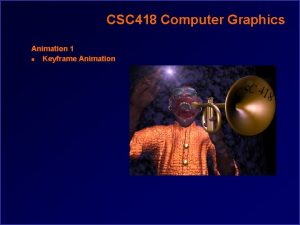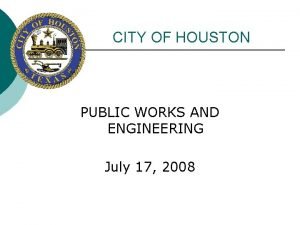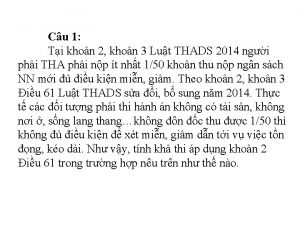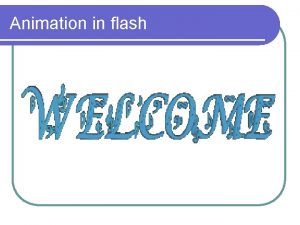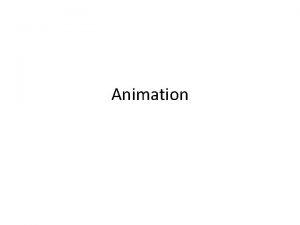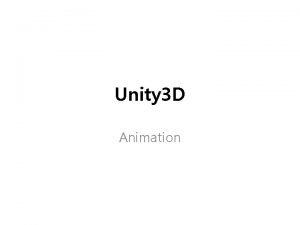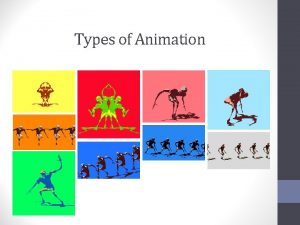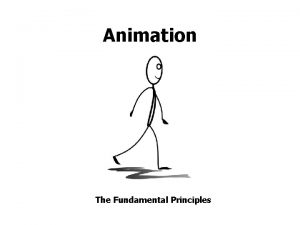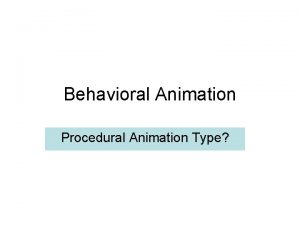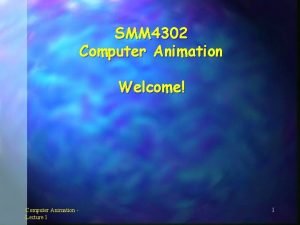Animation Rujchai Ungarunyawee Department of Computer Engineering Khon






















- Slides: 22

Animation Rujchai Ung-arunyawee Department of Computer Engineering Khon Kaen University

Understanding WPF Animation �Timer-Based Animation �Developers have to build their own animation systems from scratch �Set Timer->Event Handler->Trigger Painting-> Render in Painting code �Property-Based Animation �WPF animation is simply a way to modify the value of a dependency property over an interval of time �Every animation acts on a single dependency property �To animate a property, you need to have an animation class that supports its data type

Animation Classes �System. Windows. Media. Animation namespace � 17 Type. Name. Animation classes, which use interpolation � 22 Type. Name. Animation. Using. Key. Frames classes, which use key frame animation � 3 Type. Name. Animation. Using. Path classes, which use path-based animation �Common used properties: �From, To, By, Duration, Auto. Reverse, and Repeat. Behavior


Animations in the Code

Simultaneous Animations

Declarative Animation �Storyboard �It’s the XAML equivalent of the Begin. Animation() method. It allows you to direct an animation to the right element and property. �Event trigger. �It responds to a property change or event (such as the Click event of a button) and controls the storyboard. For example, to start an animation, the event trigger must begin the storyboard.

The Storyboard �Can use it to group multiple animations, to control the playback of animation—pausing it, stopping it, and changing its position �Use Target. Property attached properties to point to a specific property �Use Target. Name attached properties to point to a specific element

�To put several animations in the same storyboard but allow each animation to act on a different element and property.

Event Triggers

Simultaneous Animations

Animation Frame Rate �WPF always attempts 60 frames per second, unless you tell it otherwise. �Use the Timeline. Desired. Frame. Rate attached property on the storyboard

Key Frame Animation �An animation that’s made up of many short segments. �Each segment represents an initial, final, or intermediary value in the animation. �When you run the animation, it moves smoothly from one value to another.


Linear Key Frame Animations �Transitions smoothly between the key frame values

Discrete Key Frame Animations �No interpolation is performed �When the key time is reached, the property changes abruptly to the new value

Spline Key Frame Animations �Use spline interpolation to move smoothly from one key value to another �You define a cubic Bézier curve to the Key. Spline property of key frames.

Path-Based Animation �Helps you move a visual object along a path

Step 1: Build the path �Simply define as a resource �To show the path, you simply need to add a Path element that uses the geometry you’ve defined

Step 2: Create a visual object

Step 3: create the animations

 Traditional animation vs computer animation
Traditional animation vs computer animation Alfie kohn classroom management
Alfie kohn classroom management Kinh tin kính
Kinh tin kính Khon kaen
Khon kaen Kkf fishing net
Kkf fishing net Slidetodoc.com
Slidetodoc.com Faculty of education khon kaen university
Faculty of education khon kaen university Tum department of electrical and computer engineering
Tum department of electrical and computer engineering Computer engineering department
Computer engineering department What is system design in software engineering
What is system design in software engineering Csc418
Csc418 Raster animation in computer graphics
Raster animation in computer graphics Karl sims galapagos
Karl sims galapagos What is motion specification in computer graphics
What is motion specification in computer graphics Uses of computer animation
Uses of computer animation Electrical engineering department
Electrical engineering department Engineering department in a hotel
Engineering department in a hotel City of houston engineering department
City of houston engineering department Kpi for engineering
Kpi for engineering Department of information engineering university of padova
Department of information engineering university of padova Department of information engineering university of padova
Department of information engineering university of padova Eacademics iitd
Eacademics iitd University of bridgeport engineering
University of bridgeport engineering










